Organisation of the body
Added on 2023-01-06
22 Pages3965 Words51 Views
Brief
Achieved (if
ungraded) Pass Merit Distinction
Learner Declaration: I
can
confirm
that,
apart
from
correctly
reference
d
quotation
s, this is
my own
work and
contains
no
plagiarise
d
content.
All
sources
have
been
acknowledged and referenced.
Date:
Diploma Title: Access to Higher Education Diploma (
Module: Human Biology
Unit Title: Organisation of the body
Tutor/Assessor:
Title: Organisation of the body
Type of : SAQs and short essay
Word Count:
Time allowed for supervised assessment: NA
Achieved (if
ungraded) Pass Merit Distinction
Learner Declaration: I
can
confirm
that,
apart
from
correctly
reference
d
quotation
s, this is
my own
work and
contains
no
plagiarise
d
content.
All
sources
have
been
acknowledged and referenced.
Date:
Diploma Title: Access to Higher Education Diploma (
Module: Human Biology
Unit Title: Organisation of the body
Tutor/Assessor:
Title: Organisation of the body
Type of : SAQs and short essay
Word Count:
Time allowed for supervised assessment: NA
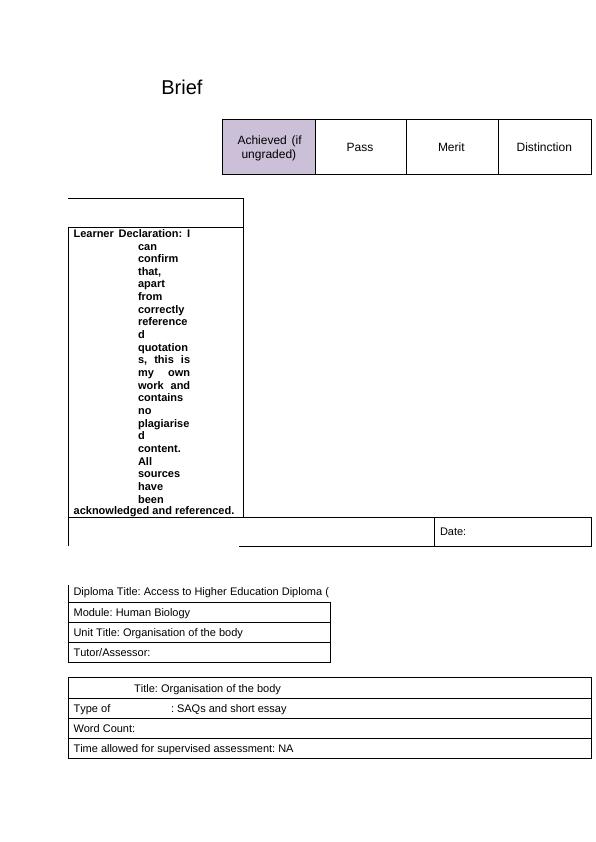
Submissions, Extensions and Referrals
Please refer to the Course Handbook for regulations relating to submission of
assessment evidence, extensions, resubmissions and referrals.
Date Issued: S
u
b
m
is
si
o
n
D
e
a
dl
in
e:
Extension negotiated? Yes No Agreed Extension Date:
Tutor Signature for
Extension:
Date of Submission: Date Marked: Resubmi
ssion
Required
? Yes /
No
Second Submission Date: Referral Requested? Yes No
Date Second Submission Marked:
Internally Verified? Yes No Internal Verifier:
No. Assessment Criteria
The Learner can:
1.1 Identify the levels of organisation in the human body and place them in order of size
from cell to organism.
1.2 Identify the organ systems of the body and explain the division of labour (tasks)
between the different organ systems.
1.3 For three human organ systems identify the organs making up each system and
outline their main functions.
2.1 Interpret data relating surface area: volume ratio and size and explain the need for cell
specialisation in multicellular organisms.
2.2 Explain the specialised features of the following human cells: ovum, sperm, motor
neuron and epithelial cell from the ileum.
2.3 Identify the four main types of tissue in the body and describe their main features.
2.4 Give two examples of each of the four tissue types outlining their specific functions
and their location in the body.
3.1 Describe the key features of stem cells compared to specialised cells.
3.2 Outline the principles of tissue engineering including the sources and culture of stem
cells and provision of an artificial scaffold
Please refer to the Course Handbook for regulations relating to submission of
assessment evidence, extensions, resubmissions and referrals.
Date Issued: S
u
b
m
is
si
o
n
D
e
a
dl
in
e:
Extension negotiated? Yes No Agreed Extension Date:
Tutor Signature for
Extension:
Date of Submission: Date Marked: Resubmi
ssion
Required
? Yes /
No
Second Submission Date: Referral Requested? Yes No
Date Second Submission Marked:
Internally Verified? Yes No Internal Verifier:
No. Assessment Criteria
The Learner can:
1.1 Identify the levels of organisation in the human body and place them in order of size
from cell to organism.
1.2 Identify the organ systems of the body and explain the division of labour (tasks)
between the different organ systems.
1.3 For three human organ systems identify the organs making up each system and
outline their main functions.
2.1 Interpret data relating surface area: volume ratio and size and explain the need for cell
specialisation in multicellular organisms.
2.2 Explain the specialised features of the following human cells: ovum, sperm, motor
neuron and epithelial cell from the ileum.
2.3 Identify the four main types of tissue in the body and describe their main features.
2.4 Give two examples of each of the four tissue types outlining their specific functions
and their location in the body.
3.1 Describe the key features of stem cells compared to specialised cells.
3.2 Outline the principles of tissue engineering including the sources and culture of stem
cells and provision of an artificial scaffold
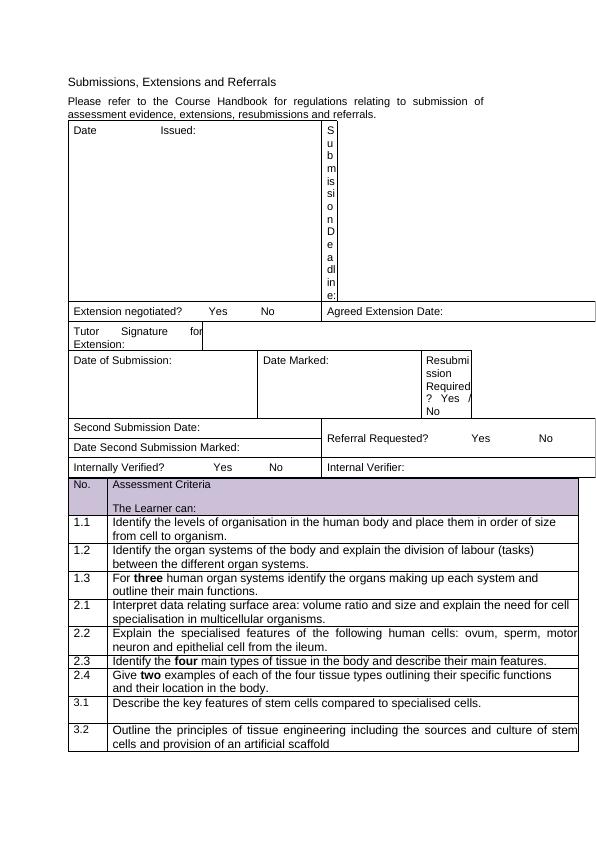
Brief:
For each of the following questions, you should research from a range of reliable resources
including books and peer reviewed articles. Use the Harvard referencing system in order to cite
and reference your work throughout.
Task 1:
1) Arrange the following statements in the correct order of size, from the smallest to largest
(AC1.1).
Molecule, cell, organ, tissue, macro-molecule, whole organism, organ system, organelle.
Answer: Correct order of Size from smallest to largest: Molecule-Organelle-Cell-Tissue-Organ-Organ
System-Organism-Whole Organism.
2) Using the tables below, identify and label the organ systems. In no more than one
sentence, state the main function of each of these organs. (AC1.2 and 1.3).
System name:
Function of the system:
Organ Name Function
1 Nasal Cavity The major function of the nasal cavity is to warm, moisture and filter
inhaled air before it passes through lungs.
2 Right Bronchus To distributes air throughout the right lung until passing respiratory
bronchioles and alveolar sacs (Knight and Nigam, 2017).
3 Alveolar It is an essential part of the respiratory system whose function is to
exchange oxygen and carbon dioxide molecules from bloodstreams.
For each of the following questions, you should research from a range of reliable resources
including books and peer reviewed articles. Use the Harvard referencing system in order to cite
and reference your work throughout.
Task 1:
1) Arrange the following statements in the correct order of size, from the smallest to largest
(AC1.1).
Molecule, cell, organ, tissue, macro-molecule, whole organism, organ system, organelle.
Answer: Correct order of Size from smallest to largest: Molecule-Organelle-Cell-Tissue-Organ-Organ
System-Organism-Whole Organism.
2) Using the tables below, identify and label the organ systems. In no more than one
sentence, state the main function of each of these organs. (AC1.2 and 1.3).
System name:
Function of the system:
Organ Name Function
1 Nasal Cavity The major function of the nasal cavity is to warm, moisture and filter
inhaled air before it passes through lungs.
2 Right Bronchus To distributes air throughout the right lung until passing respiratory
bronchioles and alveolar sacs (Knight and Nigam, 2017).
3 Alveolar It is an essential part of the respiratory system whose function is to
exchange oxygen and carbon dioxide molecules from bloodstreams.
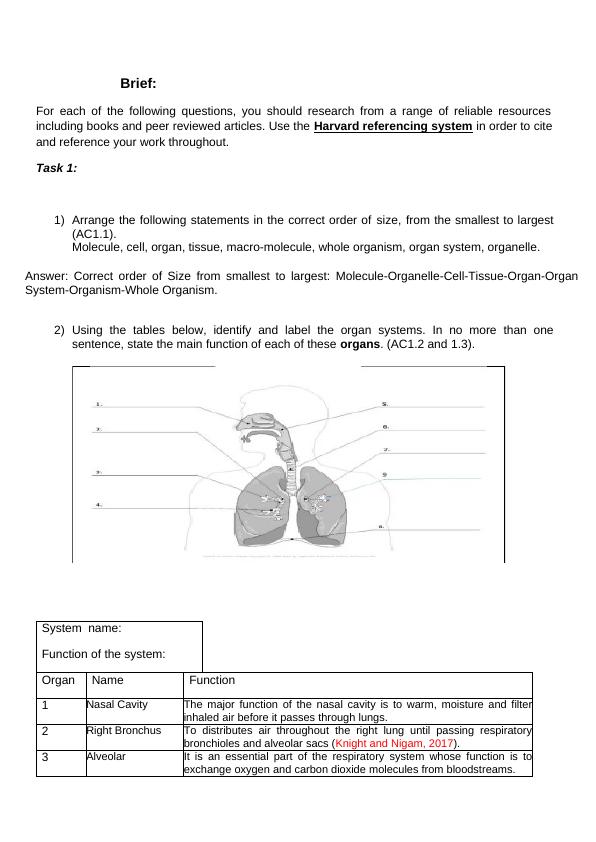
4 Bronchioles The major function of the bronchioles is to carry oxygen into lungs and
carry carbon dioxide out of the lungs, so it is aiding in the process of
respiration and breathing.
5 Pharynx (Throat) This tube delivers air from the mouth and nose to the trachea.
6 Trachea (Windpipe)It is one of the major part of the respiratory tree, that supports to
transmit oxygen to the body and removes carbon dioxide.
7 Left Bronchus Distributes air through the left lung reaching respiratory bronchioles and
alveolar sacs.
8 Alveoli These are tiny air sacs in the lungs wherein exchanges of oxygen and
carbon dioxide takes place.
9 Diaphragm It is a muscle that supports lungs pull in air and pushes it out.
carry carbon dioxide out of the lungs, so it is aiding in the process of
respiration and breathing.
5 Pharynx (Throat) This tube delivers air from the mouth and nose to the trachea.
6 Trachea (Windpipe)It is one of the major part of the respiratory tree, that supports to
transmit oxygen to the body and removes carbon dioxide.
7 Left Bronchus Distributes air through the left lung reaching respiratory bronchioles and
alveolar sacs.
8 Alveoli These are tiny air sacs in the lungs wherein exchanges of oxygen and
carbon dioxide takes place.
9 Diaphragm It is a muscle that supports lungs pull in air and pushes it out.
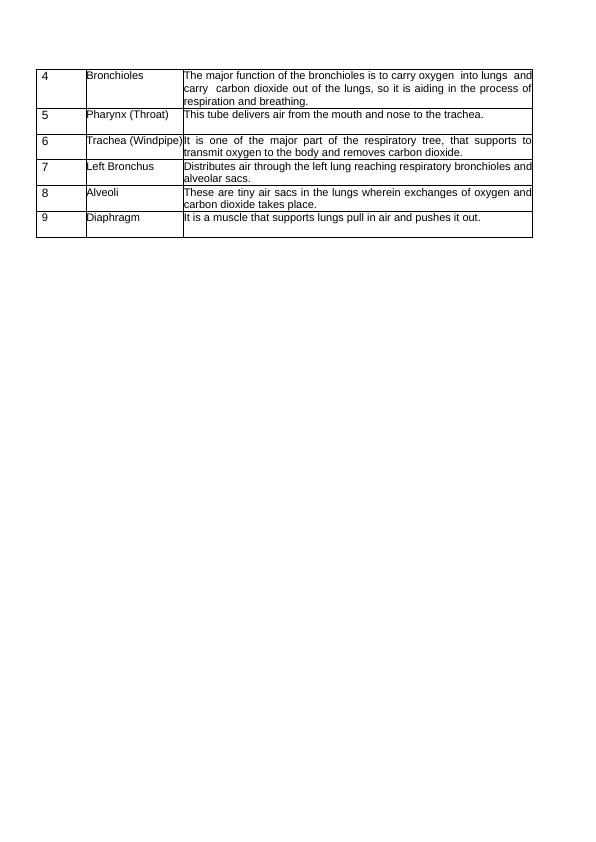
System name:
Function of the system:
Organ Name Function
1 Aorta It carries blood way from the heart to the rest of the body .
2 Pulmonary
Artery
It transfers oxygenated blood from right ventricles to the lungs directly.
3 Pulmonary
Vessel
It is the combination form of pulmonary arteries and veins that are
responsible for carrying oxygenated blood to the heart from the lungs and
carries the DE-oxygenated blood means carbon dioxide mixed blood from
the heart to the lungs.
4 Left Ventricles The main function of the left ventricles is to pump oxygenated blood from
lung to the out of the body.
5 Hepatic Portal
Nerve
It is a blood vessel that is responsible for carrying blood from GIT,
gallbladder, pancreas and spleen to the liver in last (Lupyr, 2020).
6 Iliac Vein Internal and external iliac veins develops common iliac vein that is
responsible for draining DE-oxygenated blood and returns this blood to the
heart.
7 Pulmonary
Veins
These are blood vessels that carries freshly oxygenated blood from lungs to
left atria of heart.
8 Pulmonary
Artery
These artery transfers DE-oxygenated blood from the right ventricles to the
lungs directly (Aggarwal and et.al., 2018).
Function of the system:
Organ Name Function
1 Aorta It carries blood way from the heart to the rest of the body .
2 Pulmonary
Artery
It transfers oxygenated blood from right ventricles to the lungs directly.
3 Pulmonary
Vessel
It is the combination form of pulmonary arteries and veins that are
responsible for carrying oxygenated blood to the heart from the lungs and
carries the DE-oxygenated blood means carbon dioxide mixed blood from
the heart to the lungs.
4 Left Ventricles The main function of the left ventricles is to pump oxygenated blood from
lung to the out of the body.
5 Hepatic Portal
Nerve
It is a blood vessel that is responsible for carrying blood from GIT,
gallbladder, pancreas and spleen to the liver in last (Lupyr, 2020).
6 Iliac Vein Internal and external iliac veins develops common iliac vein that is
responsible for draining DE-oxygenated blood and returns this blood to the
heart.
7 Pulmonary
Veins
These are blood vessels that carries freshly oxygenated blood from lungs to
left atria of heart.
8 Pulmonary
Artery
These artery transfers DE-oxygenated blood from the right ventricles to the
lungs directly (Aggarwal and et.al., 2018).
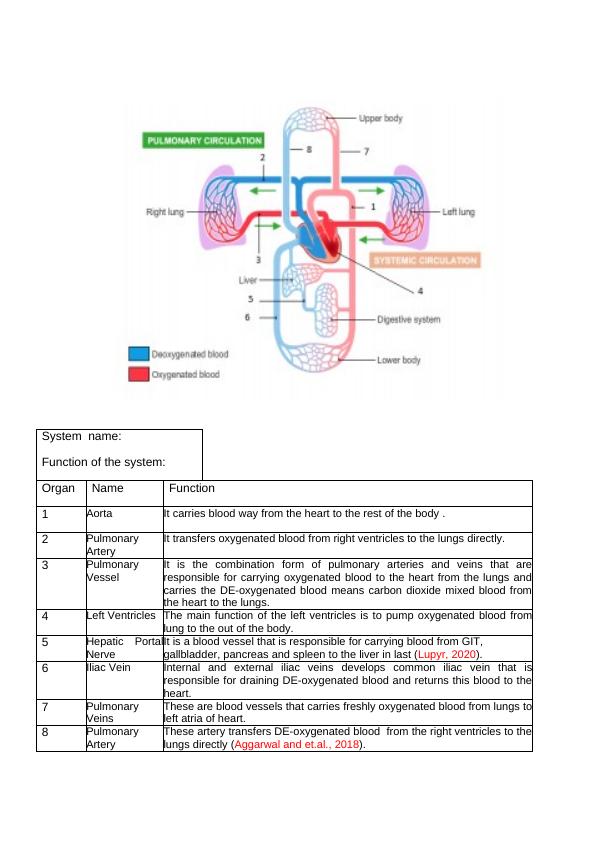
System name:
Function of the system:
Organ Name Function
1 Oral cavity The main function of the oral cavity is to adapted to get food by ingestion,
breaks into small molecules by mastication and mixes it with saliva that
takes a form of bolus that travels down to pharynx and esophagus
(Pinchbeck and et.al., 2019).
2 Esophagus It is act as transport tube that transport fluid and food from mouthy to direct
stomach.
3 Stomach The main function of the stomach is as digestion of bolus through digesting
acids and enzymes.
4 Small Intestine It is majorly involves in the digestion and absorption of nutrients or food.
5 Descending
Colon
It is a part of large intestine that is considered final part of digestive system.
The function of the descending colon is to reabsorb waste products from
the body and prepares them for elimination purpose.
6 Anus It is considered exit point of the digestive tract which supports to eliminate
waste product from the body in the form of stool (Singh and et.al., 2020).
7 Anal Canal The main function of the anal canal is to keep maintenance of fecal
continence and defecation until it is not eliminated by anus.
8 Pancreas Pancreas secrets pancreatic juice known as enzyme which is released
during digestion process. However, this enzyme act as chemical
messenger for pancreas that travels through blood.
10 Liver It regulates high level of chemical in blood and excrete product that is
known as bile.
Function of the system:
Organ Name Function
1 Oral cavity The main function of the oral cavity is to adapted to get food by ingestion,
breaks into small molecules by mastication and mixes it with saliva that
takes a form of bolus that travels down to pharynx and esophagus
(Pinchbeck and et.al., 2019).
2 Esophagus It is act as transport tube that transport fluid and food from mouthy to direct
stomach.
3 Stomach The main function of the stomach is as digestion of bolus through digesting
acids and enzymes.
4 Small Intestine It is majorly involves in the digestion and absorption of nutrients or food.
5 Descending
Colon
It is a part of large intestine that is considered final part of digestive system.
The function of the descending colon is to reabsorb waste products from
the body and prepares them for elimination purpose.
6 Anus It is considered exit point of the digestive tract which supports to eliminate
waste product from the body in the form of stool (Singh and et.al., 2020).
7 Anal Canal The main function of the anal canal is to keep maintenance of fecal
continence and defecation until it is not eliminated by anus.
8 Pancreas Pancreas secrets pancreatic juice known as enzyme which is released
during digestion process. However, this enzyme act as chemical
messenger for pancreas that travels through blood.
10 Liver It regulates high level of chemical in blood and excrete product that is
known as bile.

End of preview
Want to access all the pages? Upload your documents or become a member.
Related Documents
Respiratory Systemlg...
|16
|2909
|483
Understanding the Pathophysiology of Covid-19 and its Impact on Respiratory Systemlg...
|1
|549
|108
SCIE207 Phase 4 Lab Report Part 2: Exploring Endocrine, Circulatory, and Respiratory Systemslg...
|4
|818
|232
Assignment Brief Biology Human Cardiovascular Systemlg...
|17
|1984
|39
CHC33015 Healthy body Functions Research 2022lg...
|8
|1558
|30
HLTAAP002 Confirm Physical Health Status Assignmentlg...
|12
|5705
|448
